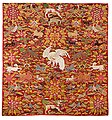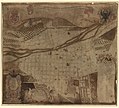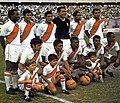Portal:Peru
Introduction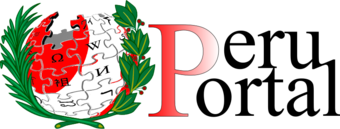
Peru, officially the Republic of Peru, is a country in western South America. It is bordered in the north by Ecuador and Colombia, in the east by Brazil, in the southeast by Bolivia, in the south by Chile, and in the south and west by the Pacific Ocean. Peru is a megadiverse country with habitats ranging from the arid plains of the Pacific coastal region in the west to the peaks of the Andes mountains extending from the north to the southeast of the country to the tropical Amazon basin rainforest in the east with the Amazon River. Peru has a population of over 32 million, and its capital and largest city is Lima. At 1,285,216 km2 (496,225 sq mi), Peru is the 19th largest country in the world, and the third largest in South America. Peruvian territory was home to several cultures during the ancient and medieval periods, and has one of the longest histories of civilization of any country, tracing its heritage back to the 10th millennium BCE. Notable pre-colonial cultures and civilizations include the Caral–Supe civilization (the earliest civilization in the Americas and considered one of the cradles of civilization), the Nazca culture, the Wari and Tiwanaku empires, the Kingdom of Cusco, and the Inca Empire, the largest known state in the pre-Columbian Americas. The Spanish Empire conquered the region in the 16th century and Charles V established a viceroyalty with the official name of the Kingdom of Peru that encompassed most of its South American territories, with its capital in Lima. Higher education started in the Americas with the official establishment of the National University of San Marcos in Lima in 1551. Peru's population includes Mestizos, Amerindians, Europeans, Africans and Asians. The main spoken language is Spanish, although a significant number of Peruvians speak Quechuan languages, Aymara, or other Indigenous languages. This mixture of cultural traditions has resulted in a wide diversity of expressions in fields such as art, cuisine, literature, and music. (Full article...) Entries here consist of Good and Featured articles, which meet a core set of high editorial standards.
 The history of Lima, the capital of Peru, began with its foundation by Francisco Pizarro on January 18, 1535. The city was established on the valley of the Rímac River in an area populated by the Ichma polity. It became the capital of the Viceroyalty of Peru and site of a Real Audiencia in 1543. In the 17th century, the city prospered as the center of an extensive trade network despite damage from earthquakes and the threat of pirates. However, prosperity came to an end in the 18th century due to an economic downturn and the Bourbon Reforms. The population of Lima played an ambivalent role in the 1821–1824 Peruvian War of Independence; the city suffered exactions from Royalist and Patriot armies alike. After independence, Lima became the capital of the Republic of Peru. It enjoyed a short period of prosperity in the mid-19th century until the 1879–1883 War of the Pacific when it was looted and occupied by Chilean troops. After the war, the city went through a period of demographic expansion and urban renewal. Population growth accelerated in the 1940s spurred by immigration from the Andean regions of Peru. This gave rise to the proliferation of shanty towns as public services failed to keep up with the city expansion. (Full article...)Selected image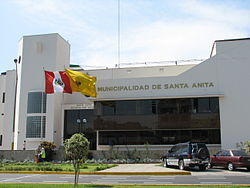 Photo credit: Ericbronder
The district of Santa Anita is one of 43 districts in the city of Lima, which are administered by the Metropolitan Lima Municipal Council. Each district has its own council and mayor (Spanish: Municipalidad distrital). The town hall in each district is the seat of the district council. (more...) Selected battleThe Battle of Arica, also known as Assault and capture of Arica Cape, is a belic action of the War of the Pacific. It was fought on June 7, 1880, between forces of Chile and Peru. After the Battle of Tacna, and the following Bolivian retirement of the war, Peru had to stand alone for the rest of the conflict. The need of a port near to the location of the army, in order to supply and reinforce the troops and the evacuation of the wounded, made the Chilean command to put its attention on the remaining Peruvian stronghold in the Tacna Department. Thus, a fraction of the Chilean army, led by Colonel Pedro Lagos, launched a simultaneous assault from both sides, taking the defenses on a bayonet charge, and captured the Morro de Arica (English: Arica Cape) from the defending Peruvian troops under the command of Colonel Francisco Bolognesi in a last attack up the hill. In this fight the Peruvian Commander died along with several officers and more than 1.000 men. (more...) In this month
General imagesThe following are images from various Peru-related articles on Wikipedia.
Selected article -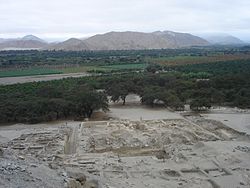 The Casma–Sechin culture (alternatively Sechin Complex) (c. 3600 BCE – 200 BCE) of Peru refers to the large concentration of pre-historic ruins in the valleys of the Casma River and its tributary the Sechin River and along the nearby coast of the Pacific Ocean. The ruins include major archaeological sites such as Sechin Bajo, Sechin Alto, Cerro Sechin, Mojeque (Pampa de las Llamas-Moxeke), Chankillo, and Taukachi-Konkan, as well as other smaller sites. Most of these inland sites are found in the river valleys about 20 kilometres (12 mi) distant from the ocean. The seaside sites of Huaynuná and Las Haldas are found about 20 kilometres (12 mi) north and south of the mouth of the Casma River on the coast. A frieze located at Sechin Bajo dated at 3600 BCE is the oldest example of monumental architecture discovered thus far in the Americas. This date, if confirmed by additional discoveries, means that the Casma/Sechin culture may have originated as early or earlier than the Caral-Supe civilization, currently considered the oldest civilization of the Americas. (Full article...)Did you know (auto-generated) -
CategoriesRelated portalsSelected quote -
South American revolutionary leader, liberator and dictator of Peru Simón Bolívar 1783–1830
Basic facts & figuresMore did you know...
Peru TopicsRecognized content
Featured articlesFeatured listsGood articles
WikiProjectsThings you can do
New articlesThis list was generated from these rules. Questions and feedback are always welcome! The search is being run daily with the most recent ~14 days of results. Note: Some articles may not be relevant to this project.
Rules | Match log | Results page (for watching) | Last updated: 2024-04-27 21:25 (UTC) Note: The list display can now be customized by each user. See List display personalization for details.
Associated WikimediaThe following Wikimedia Foundation sister projects provide more on this subject:
Discover Wikipedia using portals | |||||||||||||||









